I am attempting to design a circuit whose output is a square wave with the following properties:
- Fixed duty cycle, as high as possible (let's say 99%)
- Variable frequency, between 0.2 - 20 Hz (I'm somewhat flexible about this range)
I imagined (naively?) that such a thing would be possible using a 555 timer, wired up in astable configuration. I began exploring the problem space using an online tool that calculates duty cycle / frequency for given values of R1, R2, and C (see diagram).

It would appear that, at least in theory, I could achieve the desired effect with the following setup:
- Some fixed, reasonably high ratio of values for R1:R2 (e.g., R1 = 1 megohm / R2 = 1 kilohm); this sets the duty cycle high
- Varying the capacitor between 0.1 and 10 microfarads; this varies the frequency within my desired range without affecting duty cycle
The big problem would be in realizing this circuit with actual components. At least to my knowledge, there is no such thing as a variable capacitor with that sort of range.
I am left wondering if there is some other way to configure a 555 (besides the typical layout given above), which would provide a more realistic way to tweak frequency while holding duty cycle constant.
Alternatively, I'd be open to any suggestions on how to achieve variable capacitance from 0.1 to 10 microfarads.
Finally, I'm open to any non-555 implementations that achieve my desired result. The simpler, the better.
